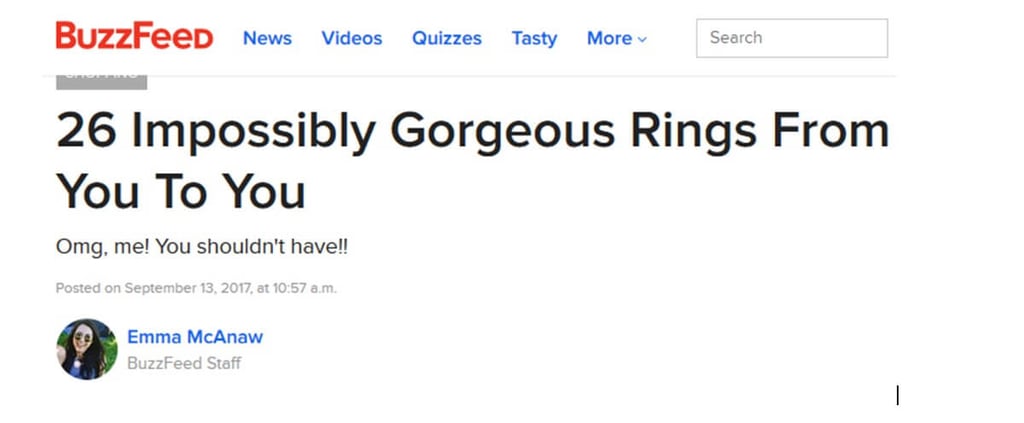Marketing messaging sometimes misses the mark. A perfect example of an advertisement that should have never gone beyond the initial pitch session is the highly controversial Pepsi commercial starring Kendall Jenner.
But it’s not just the marketing message itself that can fail to resonate with its intended audience. Too often, companies use an umbrella approach when it comes to their content development strategy – being unselective about where and how they promote their services or products.
Their goal is to market to as many people as possible, with the hopes that some of those people will be interested. But the truth is, this scattershot approach to inbound marketing leads to falsely inflated KPIs and increased spending on sales and marketing.
Here’s a notable example of a company curating content for an entirely wrong audience:

Seems fine so far, until you scroll down and start looking at the price tag for each of these “impossibly gorgeous rings”:

The average price of each cocktail ring in this list is $1,108.90 – a price that lands significantly beyond what a normal Buzzfeed reader could afford.
The reader comments confirm that Buzzfeed missed the mark when they decided which rings to include in this article. Many of Buzzfeed’s readers are in their early- to mid-20s, with entry-level jobs and starter salaries. The idea that they could afford a luxury item, like one of these rings, is ludicrous. If Buzzfeed had considered who their audience was – and wasn’t – before writing this article, they could have avoided landing so far from center.
Here's Why Smart Content Writing Services Use Negative Buyer Personas For Better Marketing Leads – And Customers
Most of us are already familiar with buyer personas or customer profiles and their powerfully positive effect on lending precision to a company’s content writing.
- 71% of companies who exceed revenue and lead goals have documented buyer personas (Cintell)
- 63% of marketers create content based on buyer personas (Curata)
But less of us are familiar with the concept of negative, or exclusionary, buyer personas, which is a term that refers to the type of customer you do not want.
By first identifying customers that you do want with positive customer profiles, and then specifying which types of customers you don’t want with negative buyer personas, your business can avoid spending time and money on low-quality leads that could turn into low-quality customers.
At this point, you may be protesting:
“Business is business. I’m not going to turn paying customers away.”
or,
“I’m willing to take any customer. Turning down revenue opportunities isn’t a smart business decision.”
If you’re operating a smaller business or your company is still getting off the ground, it’s easy to think that being selective when it comes to your customer base will inevitably lead to financial ruin. But when applied correctly, negative consumer profiles are financially beneficial in the long run.
According to the Pareto Principle, more commonly known as the ’80-20 rule’, 20% of your customers suck up about 80% of your customer costs. Ultimately, these types of customers demand too much time and investment for too little payoff. In the long run, a relationship with these types of customers just isn’t mutually beneficial. It’s not always worth nurturing a relationship with a buyer who simply isn’t a good fit for your business.
How Can You Identify Negative Buyer Personas Like A Top Content Writing Service?
When building exclusionary personas, start with your past experiences. Were there customers you’ve worked with before who required you to end the business relationship? Were there customers who ended the relationship with you? Did some customers demand constant energy and attention to manage their account? Did you receive negative reviews or feedback from individuals who purchased your services?
Begin fleshing out your personas by defining which buyer traits, behaviors and demographic data presented serious problems in the past. Once you’ve performed some foundational research, consider some of these common customer “red flags”:
- Constant Complaining
This customer seems to be perpetually dissatisfied with your work. When you ask him or her what it is about the work that dissatisfies them, you’re often met with ambiguous answers and they seldom articulate exactly what it is they want. Because of this, you spend a significant amount of time reworking deliverables for them and sending along free samples.
- Imbalanced Time-To-Profit Ratio
This client is best represented by a smaller company that purchases a modest amount of goods, but demands plenty of attention and correspondence in the form of daily phone calls, frequent e-mails and in-person meetings. The time spent on this client dwarfs the amount of revenue brought in by this client, and this type of relationship can quickly lead to your customer-facing associates feeling exhausted and frustrated.
- The Lead That Will Never Convert
You’ve pinpointed a promising content marketing lead. According to your analytics, they’ve spent hours reading and commenting on your business blog. They’ve followed most of your social media accounts and downloaded several offers - but they still haven’t converted.
Some leads will never convert, despite their high engagement indicators. There could be many reasons for this – maybe they’re simply using your content to educate themselves on a topic they’re interested in. Or perhaps your content writing isn’t targeted enough, leading customers to pursue your company as an option, only to discover that they’re not a good fit for you. Which leads to…
- Customers That Just Aren’t A Good Fit For Your Company
Consider the following example:
You’re the marketing manager for a business that sells residential solar panels. The business sells permanent-installation panels that are fairly expensive with a large upfront cost.
Based on this information, we may speculate that a positive buyer persona might be:
A middle-aged couple in their “forever home” whose children are all adults now. Collectively, this couple makes an average of $90K a year. They’re interested in alternative energy sources and reducing their environmental impact.
We can also speculate that a negative buyer persona, or a customer that’s a bad fit, might be:
A newlywed couple in their mid- to late-20s who have just purchased their first starter home and have a household annual salary of $55K.
The newlywed couple may be interested in alternative energy and reduced environmental impact, but they’re most likely not a good fit for your residential solar panels for a couple reasons: they probably can’t afford it, and a starter home is not ideal for permanent-installation panels, since the couple will likely move to another home - or homes - later on.
When customers are browsing products and services, they often use an exclusionary approach, disqualifying companies based on what they’re looking for. Don’t be afraid to use the same exclusionary approach to disqualify leads and prospective customers for your business. Before you decide where to allocate your digital marketing budget, establish some negative personas. Doing so can help you avoid a difficult relationship later on and can also help you refine your content writing, so you attract the right type of customer.
Do you need help devising the right content strategy? Your company could benefit from hiring content writing services to fuel your inbound marketing campaign. Download our free ebook to learn more about choosing the right content creators for your business.
About Virtucom Group
Consistent business blogging yields results – more clicks, more subscribers and – ultimately – more conversions. Whether you’re writing an automotive blog, an accounting blog, a healthcare blog or a home renovation blog, blogging for business and content development are useful for any industry. Follow the content writers at the Virtucom Group blog as they share digital marketing tips and discuss website content writing services that can optimize your business blog.






